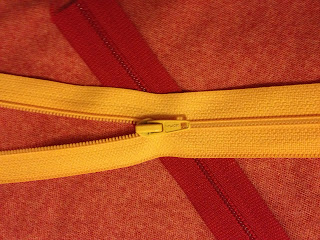It's important to remember to look at every process that goes into making a garment when you consider its sustainability. I had never put much thought into the sustainability of dyeing a garment, nor had I considered the impact of my sewing notions. But all the little things impact the end result.
Dyeing
It's impossible to imaging clothing and fashion without color. It is such an important component of our style and our wardrobe. However dyeing uses a hugh amount of water and chemicals. Globally the textile industry uses an estimate 378 billion liters of water each year, and the chemicals left over can be toxic and dangerous.
There are a few different ways to reduce the harmful effects and waste of dyeing. First, dyes can be made more efficient so that less left over dye is flushed away at the end. This can be done by using different types of dyes and other chemicals, but sometimes it has the negative effect of requiring a higher temperature water, which uses more energy.
There are water-efficient dye systems that use less water in the process, which is good to begin with. Plus since there is less water, there is less water to heat, and therefore less energy spent on heating the water. Another area to look at is re-using dye baths so that they can be re-used up to six times before being disposed. This won't work for all products, but may be good for items that use repeating colors like jeans, or uniforms.
The other way to look at dyes is to consider them from the "slow fashion" perspective. To think on a smaller scale about the local natural resources that can be used to dye clothing. This might mean picking certain flowers to use to dye in the spring, and using a type of vegetable or plant in the fall. It won't work on alarge scale, but it brings the dyeing process back down to a tangible, local level.
Notions
To be honest I'd never thought about notions (buttons, zippers, etc...) before when I thought about eco-fashion. But it's true, they do go onto everything we wear and they all have to be produced, used, and discarded. Fletcher points out that:
... trims contribute a significant ecological impact to the garment, drawing on the mining industry (in the case of metals for zips and snaps) and the oil industry (in the case of raw material for plastic buttons), with all their associated impacts on global warming, land degradation, human health, air emissions and toxic contamination of water bodies.
 Fletcher also mentions that the type of notion used can have an impact on the life of a garment. More garments with zippers for closures are thrown away early in their life cycle compared to those with other closures. This is because people are much more likely to sew on a button to fix a garment than re-sew a zipper. So often when a zipper breaks, the whole garment goes in the trash.
Fletcher also mentions that the type of notion used can have an impact on the life of a garment. More garments with zippers for closures are thrown away early in their life cycle compared to those with other closures. This is because people are much more likely to sew on a button to fix a garment than re-sew a zipper. So often when a zipper breaks, the whole garment goes in the trash.
In addition, the notions cannot be recycled with the rest of the garment. They either slow down the recycling process by causing labor intensive removal, or they send a garment that would normally be recycled to the landfill.
***
I've thought about experimenting with natural dyes for my final class project, however I'm not sure that I will. It seems a bit too much to take on, and too much risk (especially since I have no previous dyeing experience). I may try to tackle the notion challenge though. As you will see in my zero waste garment, I tried to find a solution for closing the jacket that didn't use any notions at all.

No comments:
Post a Comment